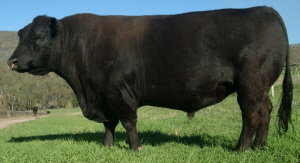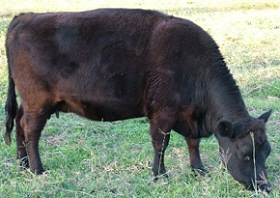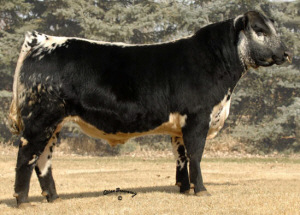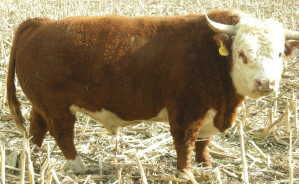



Lowline
History
Australian Lowline Cattle were developed from an Aberdeen Angus herd which was established at the Trangie Research Centre in 1929, they were bred to provide quality breeding stock for the NSW cattle industry.
Seed stock were purchased from Scotland, Canada, America and selected Australian Studs to form the foundation of the herd.
The emphasis at Trangie switched to research in 1963, the Australian Meat Research Committee asked the Trangie Research Centre to conduct a project aimed at establishing the role of performance recording in the breeding program of a herd. Emphasis was given to weight gain and to visual conformation score in the selection of replacement bulls and heifers. The project continued until 1970, pioneering performance testing in Australia, and demonstrating successfully the usefulness of measuring performance in a stud herd.
The Lowline breed trials began in 1974 to evaluate selection for growth rate on herd profitability.
 Photo courtesy of Vitulus Lowline Stud, www.lowline.com.au |
The Trangie staff chose one herd selected for high yearling growth rates and another selected for low yearling growth rates, with a randomly selected control group. The dubbed the herds Highline, Lowline and Control Line. Satellite herds were established at Glen Innes in the northern tablelands of NSW and at Hamilton in the Western Districts of Victoria to enable climate to be taken into account.
All were evaluated on weight gain, feed intake, reproductive performance, milk production, carcass yield and quality and structural soundness. The protein conversion performances of the Highline and the Lowline cattle were monitored and recorded on an individual basis. The lines continued to grow apart with the selection process and recorded on an individual basis.
After 15 years, the Lowline had stabilised at 30% smaller than the Highline cattle. The bulls matured at about 43 inches, and the cows at about 39 inches or less, against 59 inches for standard Angus bulls, and close to the same height for standard Angus cows.
Interested cattlemen bought Lowline cattle from the dispersal sales from the termination of the trials at Trangie and Glen Innes, and in 1992 created the Australian Lowline Cattle Association. Although the aim was not to create a new breed, the Lowline has proved successful and interest in the breed has increased ever since.
Australian Lowlines are of champion stock with an Australian history dating back to 1929, and beyond that in Canada, the United States, England and Scotland. They are docile, and well conformed. They offer small holders and those farmers with limited acreage available from their other activities the option of keeping docile cattle of high quality. The Scots who first developed black cattle would be as proud of the Lowlines as of any of their giant cousins. They made their first appearance at the Brisbane Royal National in 1994, and subsequently at the Sydney Royal Show in 1995, and Melbourne and Canberra Royals in 1996. They are now regular exhibits at agricultural shows around Australia.
Characteristics
The Lowline is smooth and black in colour although a little white is not uncommon. The breed is naturally polled and are of similar comformation to any British beef breed. Mature bulls measure about 110cm at the hip and mature females, 100cm.
They are free from waste, and produce high quality meat. They are free from eye cancer and they have proved adaptable to Australian conditions. They are also exceptionally docile.
 Photo courtesy of Timitch Hill Lowline Cattle Breeders, www.tmhlowline.com |
Statistics
Comparative
Lowline, in recent comparisons, score favourably in the efficiency of primal cut production when considering eye muscle to body weight ratio, producing nearly twice as much eye muscle as the other breeds.
Another significant attribute of the breed for the commercial beef market is the high yield percentage that Lowline provide. Figures provided by one butcher, who has been in the business for some 43 years, gave yield figures of 76.13% and 74.21% for pure-bred Lowline steers.
lowline.une.edu.au
Distribution
The Lowline is being produced in Australia, New Zealand, Canada and the USA.
References (the above information was cited from the following sites)
www.usa-lowline.org
lowline.une.edu.au
www.lowline.com.au
www.tmhlowline.com


